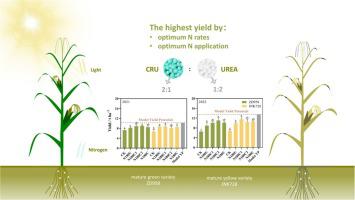当前位置:
X-MOL 学术
›
Field Crops Res.
›
论文详情
Our official English website, www.x-mol.net, welcomes your feedback! (Note: you will need to create a separate account there.)
Maize yield increased by matching canopy light and nitrogen distribution via controlled-release urea /urea adjustment
Field Crops Research ( IF 5.8 ) Pub Date : 2024-02-06 , DOI: 10.1016/j.fcr.2024.109284 Huan Li , Yiming Zhu , Gaofeng Wang , Rongrong Liu , Da Huang , Miaomiao Song , Yihan Zhang , Hao Wang , Yongchao Wang , Ruixin Shao , Jiameng Guo , Qinghua Yang
Field Crops Research ( IF 5.8 ) Pub Date : 2024-02-06 , DOI: 10.1016/j.fcr.2024.109284 Huan Li , Yiming Zhu , Gaofeng Wang , Rongrong Liu , Da Huang , Miaomiao Song , Yihan Zhang , Hao Wang , Yongchao Wang , Ruixin Shao , Jiameng Guo , Qinghua Yang

|
Rational fertilization can optimize canopy structure, uniformly distribute light and nitrogen, improve photosynthetic characteristics, and accumulate dry matter to improve maize yield. However, the basic physiological and agronomic mechanisms The objective of our study is to examine the spatial distribution of nitrogen and light within maize canopies in order to optimize future maize yields. In the 2021 and 2022 growing seasons, a two-year field experiment was conducted to assess the performance of two maize varieties: ZD958 (green maturity) and JNK728 (yellow maturity). Five fertilizer treatments were applied, including CK (zero N); N180U (180 kg N ha, all Urea-N); N180C1 (180 kg N ha, CRU-N: Urea-N = 1:2); N180C2 (180 kg N ha, CRU-N: Urea-N = 2:1); and N180C (180 kg N ha, all CRU-N). Multivariate characteristics of canopy leaves, canopy light conditions, and nitrogen distribution were measured. Grain yield was simulated using a hybrid maize model based on crop management practices and climate interactions. Maize treated with CCU also intercepted more radiation through adjustment of leaf area; there was a significantly increase in the content of nitrogen in the leaves, and the coordination between nitrogen and light distribution in the canopy was significantly improved by the CCU treatments, all of which contributed to the plant maximum utilization of solar radiation. The CCU optimized the canopy distribution of nitrogen and light and improved shoot biomass, which improved grain yield. Significant increases in yield were observed in the N180C2 treatment of ZD958 and N180C1 treatment of JNK728, compared to N180U. A suitable CCU applied to the right varieties (N180C2 treatment of ZD958 and N180C1 treatment of JNK728) could optimize canopy structure and increase grain yield in maize systems. This experiment provides a new idea for maize intensive production and reducing environmental pollution and other aspects of nitrogen management in some areas the North China Plain.
中文翻译:

通过控释尿素/尿素调节来匹配冠层光照和氮分布,从而提高玉米产量
合理施肥可以优化冠层结构,均匀分配光氮,改善光合特性,积累干物质,提高玉米产量。然而,基本的生理和农艺机制我们研究的目的是检查玉米冠层内氮和光的空间分布,以优化未来的玉米产量。在2021年和2022年生长季节,进行了为期两年的田间试验,评估两个玉米品种的性能:ZD958(绿色成熟)和JNK728(黄色成熟)。施用五种肥料处理,包括CK(零氮); N180U(180 千克氮/公顷,全部为尿素-N); N180C1(180千克N公顷,CRU-N:尿素-N = 1:2); N180C2(180千克氮·公顷,CRU-N:尿素-N = 2:1);和 N180C(180 千克 N 公顷,全部为 CRU-N)。测量了冠层叶片的多变量特征、冠层光照条件和氮分布。使用基于作物管理实践和气候相互作用的杂交玉米模型模拟谷物产量。经过 CCU 处理的玉米还可以通过调整叶面积拦截更多的辐射; CCU处理使叶片中氮含量显着增加,冠层氮与光分布的协调性显着改善,这些都有助于植物最大限度地利用太阳辐射。 CCU 优化了冠层氮和光的分配,提高了地上部生物量,从而提高了谷物产量。与N180U相比,在ZD958的N180C2处理和JNK728的N180C1处理中观察到产量显着增加。将合适的 CCU 应用于正确的品种(ZD958 的 N180C2 处理和 JNK728 的 N180C1 处理)可以优化玉米系统的冠层结构并提高谷物产量。该试验为华北平原部分地区玉米集约化生产、减少环境污染等氮素管理提供了新思路。
更新日期:2024-02-06
中文翻译:

通过控释尿素/尿素调节来匹配冠层光照和氮分布,从而提高玉米产量
合理施肥可以优化冠层结构,均匀分配光氮,改善光合特性,积累干物质,提高玉米产量。然而,基本的生理和农艺机制我们研究的目的是检查玉米冠层内氮和光的空间分布,以优化未来的玉米产量。在2021年和2022年生长季节,进行了为期两年的田间试验,评估两个玉米品种的性能:ZD958(绿色成熟)和JNK728(黄色成熟)。施用五种肥料处理,包括CK(零氮); N180U(180 千克氮/公顷,全部为尿素-N); N180C1(180千克N公顷,CRU-N:尿素-N = 1:2); N180C2(180千克氮·公顷,CRU-N:尿素-N = 2:1);和 N180C(180 千克 N 公顷,全部为 CRU-N)。测量了冠层叶片的多变量特征、冠层光照条件和氮分布。使用基于作物管理实践和气候相互作用的杂交玉米模型模拟谷物产量。经过 CCU 处理的玉米还可以通过调整叶面积拦截更多的辐射; CCU处理使叶片中氮含量显着增加,冠层氮与光分布的协调性显着改善,这些都有助于植物最大限度地利用太阳辐射。 CCU 优化了冠层氮和光的分配,提高了地上部生物量,从而提高了谷物产量。与N180U相比,在ZD958的N180C2处理和JNK728的N180C1处理中观察到产量显着增加。将合适的 CCU 应用于正确的品种(ZD958 的 N180C2 处理和 JNK728 的 N180C1 处理)可以优化玉米系统的冠层结构并提高谷物产量。该试验为华北平原部分地区玉米集约化生产、减少环境污染等氮素管理提供了新思路。



























 京公网安备 11010802027423号
京公网安备 11010802027423号